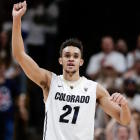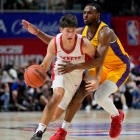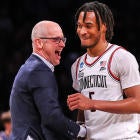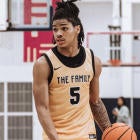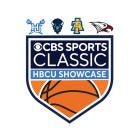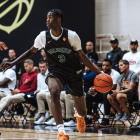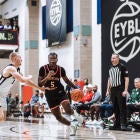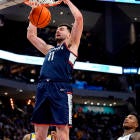Scottie Pippen. Steve Francis. Ben Wallace. Jack Sikma. Avery Johnson. John Starks. Terry Porter.
Next: Derrick White.
Commonality? All of them, somehow, did not earn a single Division I basketball scholarship offer coming out of high school. Once White is drafted and inevitably suits up in an NBA game later this fall, he'll join the aforementioned seven in having played in the greatest basketball league the world has ever known, despite being sweepingly ignored.
But unless you're a hardcore college basketball fan, an NBA Draft junkie or watched the Pac-12 regularly last season, you may have no idea who Derrick White is. You may not know the name, the game, his look, any of it. But, once you watch him play, he's hard to shake from your mind. There's a captivating element to his style. He's lean but not lanky to a fault. His untamed, curly hair bobs with joy. Most fun: his seemingly mutant-type ability to elasticize himself whenever he dunks in traffic.
White, who just played one season at Colorado, should be a top-40 pick. Amazingly, a year ago at this time, almost nobody outside the Rocky Mountain State knew who he was. White has perhaps the most interesting and unexpected story of any projected draftee. He is the latest example of a role model for the overlooked, an illustration of how you can achieve lofty dreams through measured humility paired with a ferocious desire to never settle. Because 99.999 percent of the time, athletes in Derrick White's position spray off en route to NBA Draft dreams.
"It's a great story from the standpoint it's going to give a lot of kids hope, gives me hope," Colorado coach Tad Boyle said. "There's Derrick White out there, where's the next one? And there's not very many of them."
White, the anomaly, has broken through. He is the only "one-and-done" player in this draft that is not a freshman; he qualifies for the title as an outgoing senior, having played just one season at the Division I level.
Last season with Colorado, White averaged 18.3 points, 4.4 assists, 4.1 rebounds on 40-percent 3-point shooting. He was First Team All-Pac-12. Most recently, White was a standout at the annual, seniors-only Portsmouth Invitational Tournament, one of the great pre-draft events that gives guys like White a chance to shine without the glare of one-and-done types overtaking the scene. The PIT has been held since the 1950s and changed the career course for many NBA players over the years. For White, it amounts to his latest springboard validating a late-blooming reputation.
According to Draft Express: "White fared relatively well in the athletic testing posting average marks in the speed and agility testing, coming through with an impressive 34 inch no-step vertical leap, which would have been one of the top marks among guards at last year's NBA Combine."
Here he is now, nearly 23 years old, and on the verge of becoming just the sixth player from the University of Colorado in the past 20 seasons to be picked. He'll be the first player in almost as long to earn a draft spot after not earning a Division I scholarship coming out of high school.
This is what he looked like as a freshman at Legend High School, in his hometown of Parker, Colorado. Practically a waif. He wasn't the best player on that team until he was a junior. White matriculated at Legend when it opened, as part of the seventh-, eighth- and ninth-grade classes that made up the student body. The team played meager varsity schedules at the 3A level when White was a freshman and sophomore, and then, after the school's enrollment bumped bigtime, the team was playing in 5A — the biggest division in the state.
"I remember distinctly, we didn't have our own gym yet, we were having practices at the local middle school," said Kevin Boley, White's high school coach. "Skinny kid with curly hair shooting around. You could tell right away he was a special kind of kid. I had known about him, and once he was coming to Legend that was a game-changer for us."
Boley was no wide-eyed new coach. He previously won a state title at Colorado's Broomfield High School and had taken his teams to seven state tournaments. By White's final six-game stretch of his senior year, he was averaging nearly 30 points and dominating.
"I can remember local schools would watch him at team camp or watched us play and they liked him but they couldn't look at him and see what he was going to be," Boley said. "You know, I get it. If I'm a college coach and my job depends winning now, that sort of thing, I'm looking for those big-time athletes that give me immediate gratification. I'm not looking for those kids that might have to redshirt and I have to wait to develop."
Boley developed a relationship with Colorado coach Tad Boyle years prior. White's development was so late that Boley never even pitched Boyle on White being a Colorado-level recruit, not even when Legend went to CU for team camps.
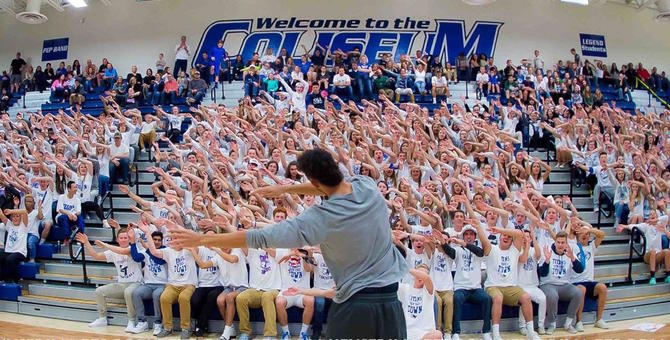
So how does Derrick White's story happen? In part because of him being a late bloomer, but also in part because he didn't play conventional AAU basketball during the spring and summer. Because of that, D-I coaches never saw him. The recruiting beat writers who attend dozens of travel tournaments every spring and summer? They never saw him either. White did play in AAU-type travel tournaments in big cities, but they were with his high school team. (You know, the way it used to be done, instead of being the exception that it's become.) Because he was playing on a team with no Division I recruits or shoe-company sponsorships, White was always playing in small, auxiliary gyms.
His team was never placed in the brackets alongside big programs with rosters boasting seven, eight, nine, 10 future Division I players. White had no reputation outside of Parker.
"I felt like I could play and had a lot of confidence, but when none of them would talk to you, you accept what you've got and try to make the most out of it," White told CBS Sports.
His only offers coming out of high school were to D-II University of Colorado-Colorado Springs and Gillette Junior College, in Wyoming. And he only earned the D-II look because the coach there, Jeff Culver, was taking over the program after coaching at Johnson & Wales' Denver-based campus.
"Derrick trained with Cory Calvert (recruited to BYU) and Josh Adams (Wyoming)," Boley said. "Cory was more developed and Josh was a freak athlete and getting attention. Derrick was every bit as good, maybe even better than them, in those workouts. I have no doubt Derrick was frustrated with that, but he's such a humble kid, he never resented those guys, never had an an attitude."
Said Boyle: "The thing I love about Derrick White: he did not get where he is with hype. The rankings and all this bulls--- that goes on with grassroots basketball. Derrick White is not a product of that. He's not a product of the hype culture, the rankings culture that so many of these kids are part of. It's refreshing. We said it as a staff throughout the year, it's refreshing to coach a kid like this. He's been traveling on buses and eating at Golden Corral, and now we got to Outback Steakhouse and he thinks he's at Ruth's Chris. 'Thanks, Coach.' There's an appreciation there."
There was another obvious reason for the overlook: White was barely 6-foot-1 during his senior season and weighed all of 150-155 pounds. But by the time he enrolled for classes at UCCS, he hit his growth spurt, popping to 6-foot-5. Within a few practices his freshman year, Culver burned White's redshirt and inserted him into the starting lineup. The team went from 21 losses in White's freshman year to 21 wins the following season. Despite a 5-21 record, White was Freshman of the Year in the Rocky Mountain Athletic Conference (RMAC), a year White remembers as one where "I didn't think I played that great, a lot of room for improvement."
By the time his sophomore year was completed, White added a mid-range game, possessed a floater, eliminated his charges and got control of his loss of control. He averaged 22 points that season and helped initiate the greatest era in the history of UCCS basketball. After losing to Metro State in the league title game and again in the program's first-ever NCAA Tournament appearance as a sophomore (White had always wanted to play for Metro State), UCCS swept Metro the following year.
"It kind of pissed me off that we lost four times to them, and I was thinking of transferring after that year," White said.
He didn't, though. He stayed true to UCCS, shook off sudden interest from D-I mid-majors and wound up becoming one of the most dominant D-II players in the history of the region. White became a deadly 3-pointer shooter, averaged 27 points as a junior (setting the school's single-season and career record for points) and helped UCCS win its first league title in school history. The team made the NCAA Tournament again and finished 27-6.
"After his sophomore year, Boise State, Wyoming, Colorado State reached out," Boley said. "I think he was incredibly loyal to coach Culver and UCCS."
White became a D-II All-American as a junior at UCCS and had a 50-point, 14-rebound, eight-assist performance in the NCAA Tournament. It was after that game when White first believed, for real, he'd have a chance at the NBA one day. Within a few months, he knew it would be true.
But after all he'd proven at UCCS, Colorado was the only school from a power conference that showed interest. He signed on his one and only official visit, making the 95-mile move north from Colorado Springs to Boulder.

Boyle took White in at Colorado based only off of watching him on video and seeing his stats. He never saw him in person. But he trusted those who had, particularly the coaches White was abusing with his even-keel-but-killer style.
"A lot of these coaches have been up to these practices and seen us play," Boyle said. "Every one them was like, 'He's good enough. He's special.'"
In 2016-17, he turned into one of the biggest breakout players in the sport. Nobody outside of Boulder, Colorado Springs or Parker saw this coming. Emboldened by a redshirt year, White became the best multi-faceted player in the Pac-12 not named Lonzo Ball or Markelle Fultz.
"His personality with meshing with three other fifth-year seniors and juniors was perfect," Boyle said. "He didn't come in with a boisterous personality, rubbing people the wrong way or talking trash. He was workmanlike, came to practice every day, and in the games what I thought was great, as the year went on he kept getting better and better and better."
His signature game was the 31 points, six rebounds, five assists and two steals he put on Arizona in the Pac-12 Tournament.
"There wasn't a lot anybody could do about it," Boyle said, adding, "NBA people telling me he's an average athlete. But he'll make plays that are 'wow'-type plays. One of the coaches I talked to, he mentioned to me he's a tremendous shot-blocker. And when you think about a 6-5 guard or wing, you don't think of a shot-blocker. He was fifth in the league in blocked shots down the stretch. He won a couple games for us just blocking shots in transition. He can do so many things and defend in so many ways."
Plus, White was moved to point guard at CU … basically because he adapted to it so naturally and his decision-making was instinctually solid. White is versatile. He's smart on and off the ball. He can guard multiple positions and has NBA range. The only thing that will be held against him: his age. If he possessed the skills he has now as 19-year-old D-I player, he'd be a guaranteed lottery pick.
Boley has been getting calls from NBA teams in recent weeks. They're asking if the story is too good to be true. Is Derrick this good of a kid, is he what we're hearing?
"I look at this a lot like when Derrick was coming out of high school," Boley said. "You've got to see the big picture here, you've got to see the upside. You've got to let him develop and grow, because he only got one year in the Pac-12. Sitting was so good for him. Derrick White's the best player in the gym right now, right when he gets there. Derrick was an unselfish player, and if anything, his stats were 75 percent, maybe 70 percent, of what they could have been."
In speaking with White, he was eager, humble, laid-back. He spoke of how it felt weirdly thrilling to pick an agent; it was the first time he was ever really recruited. He's been living in a house in New York City with fellow draft hopefuls (and some locks): Kentucky's Malik Monk, Duke's Harry Giles, Iowa State's Naz Mitrou-Long and Oregon's Dylan Ennis and Dillon Brooks .
All of those guys were four- and five-star recruits. All stars from the ages of 15 and on. White is anything but. He avoids social media and refuses to keep track of mock drafts.
His story is not unprecedented, but it is a rarity, and the reality is that most players who do not earn a Division I scholarship coming out of high school — but then work their way to the NBA — those players do not flame out. Most, in fact, become starters. Many of them stars (check those names at the top of the story again). White's done all of this while finishing up school. Colorado's commencement and graduation ceremonies will be held this Friday. White would love to be there, but something else came up.
The kid who had one Division II offer coming out of high school has picked up a coveted invite to the NBA combine.








